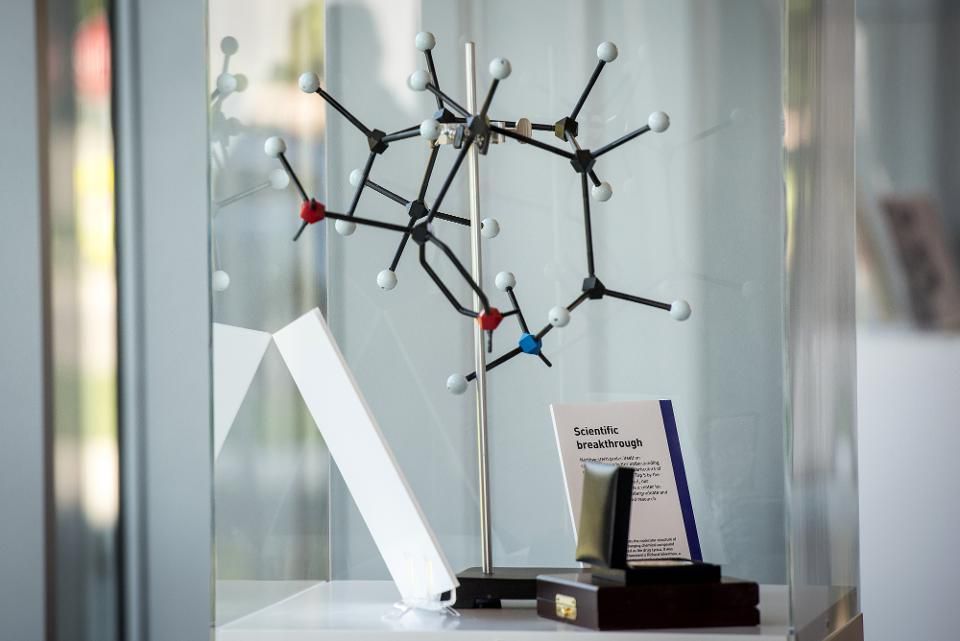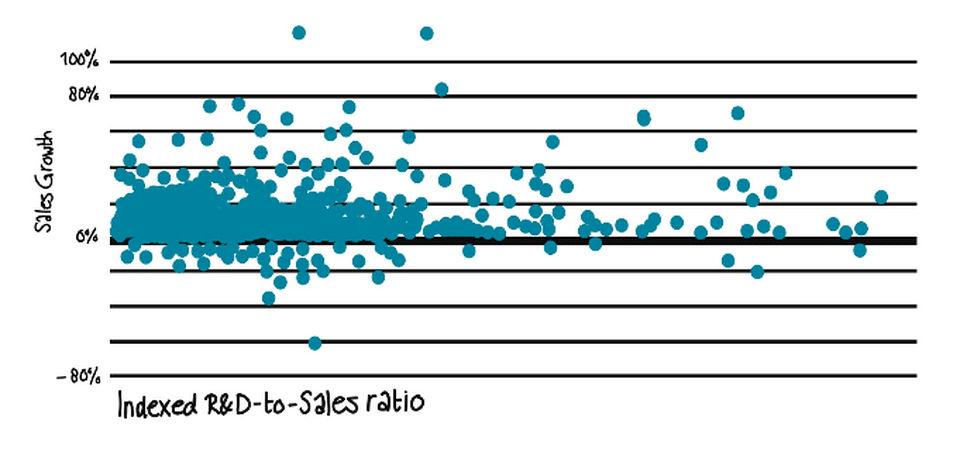
When it comes to R&D spending, corporate leaders often want to know what others are doing. How much are other companies in different industries spending on R&D? Leaders want to know the level of spending in absolute terms (i.e. total expenditure), and also as a percentage of revenue. The presumption is that R&D spending is somehow connected to increased innovation, revenue growth and profits.
However, leaders may be asking the wrong questions here. A focus on R&D spending might be a good way to gauge best practice within an industry, but it is not a measure of how innovative any company really is. Having a great R&D process and achieving market success with the technologies we invent are two different things.
Strategy&, a business unit within PriceWaterhouseCoopers, has been publishing an annual report of the top 1000 most innovative companies in the world for over 12 years now. In that time, it has found no statistically significant relationship between R&D spending and sustained financial performance. Its findings apply to total R&D spend, as well as R&D spending as a percent of revenues. Spending on R&D is not related to growth in sales or profits, increases in market capitalization or shareholder returns. In every single annual report that Strategy& has published, the top 10 most innovative companies are rarely the top 10 spenders on R&D.

Strategy&’s research makes it clear that it is not the amount of money spent on R&D that produces innovation success. But why might this be the case? Steve Blank distinguishes between technical risk and market risk. Technical risk is about whether a company is capable of creating new technologies and making them work. In contrast, market risk is about whether customers will buy and use the product, even if the technology works.
Innovation is about solving for both technical and market risk. The challenge with R&D labs is that they have traditionally focused on solving for technical risk only. While this might increase a company’s number of patentable technologies, it does not guarantee the success of those technologies in the market. To solve for market risk, companies need innovation frameworks and processes that allow them to search for sustainable business models.
Innovation requires that companies develop a deep understanding of customer needs in order to be able to make products people want. The ability to create products that serve genuine customer needs is the foundation for successful innovation. In addition to making products people want, companies also need to develop good business models to support those products. Their work here is to figure out whether they can create and deliver customer value in a manner that is sustainably profitable.
A successful innovation process has very little to do with the exact amounts of money we spend. It is true that we do not want to starve our R&D labs of money and resources. Benchmarking our own expenditures against industry standards is a good way to ensure that we have a healthy R&D department. But even more important is how we spend the money we are investing in R&D. Companies must align R&D with strategy and ensure that they have robust innovation management processes in place to take products to market.
Leadership teams need to understand that:
innovation = invention + customer value + business model
All three elements of innovation need investment and management. So beyond asking how much other companies spend on R&D, more important questions are: How do successful innovators manage their R&D investments? What do they actually spend their money on? What are their innovation management processes? What do successful innovators do day to day to test and prepare their products for the market? Knowing the answers to these questions is by far more important than knowing how much money is spent on R&D.
Originally published on Forbes
Photographer: Christopher Dilts/Bloomberg

Thinkers50 Limited
The Studio
Highfield Lane
Wargrave RG10 8PZ
United Kingdom

Thinkers50 Limited
The Studio
Highfield Lane
Wargrave RG10 8PZ
United Kingdom

Thinkers50 Limited
The Studio
Highfield Lane
Wargrave RG10 8PZ
United Kingdom
| Cookie | Duration | Description |
|---|---|---|
| LANG | 9 hours | Linkedin set this cookie to set user's preferred language. |
| nsid | session | This cookie is set by the provider PayPal to enable the PayPal payment service in the website. |
| sp_landing | 1 day | The sp_landing is set by Spotify to implement audio content from Spotify on the website and also registers information on user interaction related to the audio content. |
| sp_t | 1 year | The sp_t cookie is set by Spotify to implement audio content from Spotify on the website and also registers information on user interaction related to the audio content. |
| tsrce | 3 days | PayPal sets this cookie to enable the PayPal payment service in the website. |
| x-pp-s | session | PayPal sets this cookie to process payments on the site. |
| __cf_bm | 30 minutes | This cookie, set by Cloudflare, is used to support Cloudflare Bot Management. |
| Cookie | Duration | Description |
|---|---|---|
| l7_az | 30 minutes | This cookie is necessary for the PayPal login-function on the website. |
| Cookie | Duration | Description |
|---|---|---|
| CONSENT | 2 years | YouTube sets this cookie via embedded youtube-videos and registers anonymous statistical data. |
| _ga | 2 years | The _ga cookie, installed by Google Analytics, calculates visitor, session and campaign data and also keeps track of site usage for the site's analytics report. The cookie stores information anonymously and assigns a randomly generated number to recognize unique visitors. |
| _gat_gtag_UA_10408481_1 | 1 minute | Set by Google to distinguish users. |
| _ga_ZP8HQ8RZXS | 2 years | This cookie is installed by Google Analytics. |
| _gid | 1 day | Installed by Google Analytics, _gid cookie stores information on how visitors use a website, while also creating an analytics report of the website's performance. Some of the data that are collected include the number of visitors, their source, and the pages they visit anonymously. |
| Cookie | Duration | Description |
|---|---|---|
| NID | 6 months | NID cookie, set by Google, is used for advertising purposes; to limit the number of times the user sees an ad, to mute unwanted ads, and to measure the effectiveness of ads. |
| test_cookie | 15 minutes | The test_cookie is set by doubleclick.net and is used to determine if the user's browser supports cookies. |
| VISITOR_INFO1_LIVE | 5 months 27 days | A cookie set by YouTube to measure bandwidth that determines whether the user gets the new or old player interface. |
| YSC | session | YSC cookie is set by Youtube and is used to track the views of embedded videos on Youtube pages. |
| yt-remote-connected-devices | never | YouTube sets this cookie to store the video preferences of the user using embedded YouTube video. |
| yt-remote-device-id | never | YouTube sets this cookie to store the video preferences of the user using embedded YouTube video. |
| yt.innertube::nextId | never | This cookie, set by YouTube, registers a unique ID to store data on what videos from YouTube the user has seen. |
| yt.innertube::requests | never | This cookie, set by YouTube, registers a unique ID to store data on what videos from YouTube the user has seen. |
| Cookie | Duration | Description |
|---|---|---|
| DEVICE_INFO | 5 months 27 days | No description |
| loglevel | never | No description available. |
| m | 2 years | No description available. |
Thinkers50 Limited has updated its Privacy Policy on 28 March 2024 with several amendments and additions to the previous version, to fully incorporate to the text information required by current applicable date protection regulation. Processing of the personal data of Thinkers50’s customers, potential customers and other stakeholders has not been changed essentially, but the texts have been clarified and amended to give more detailed information of the processing activities.